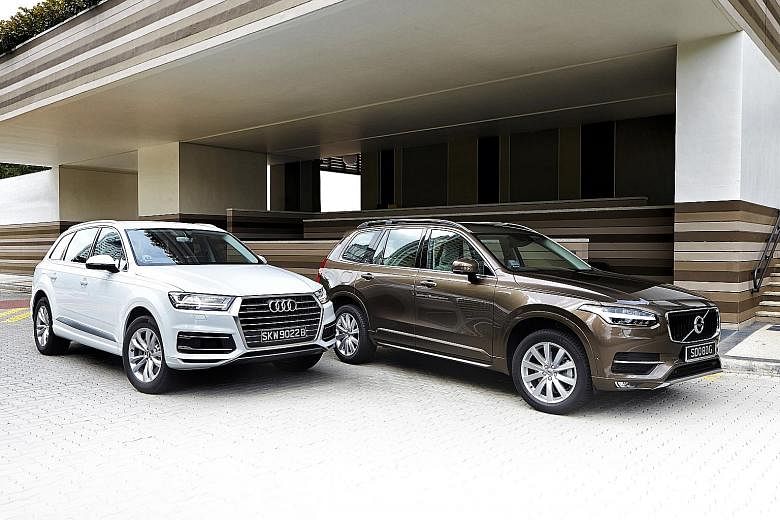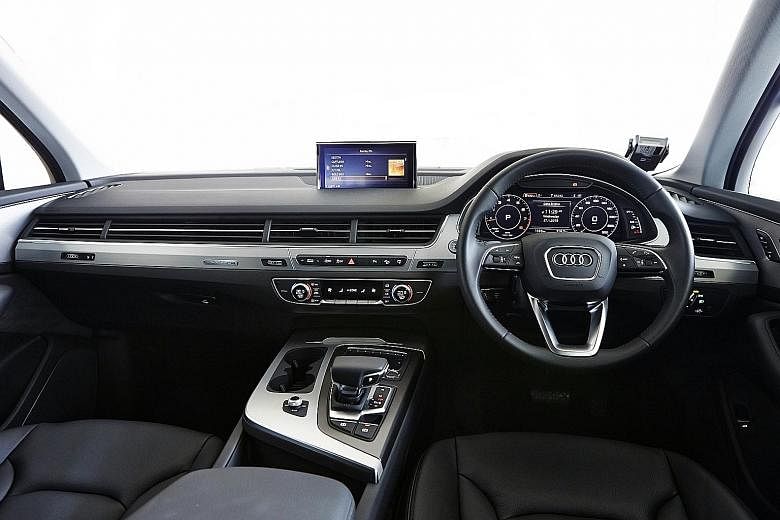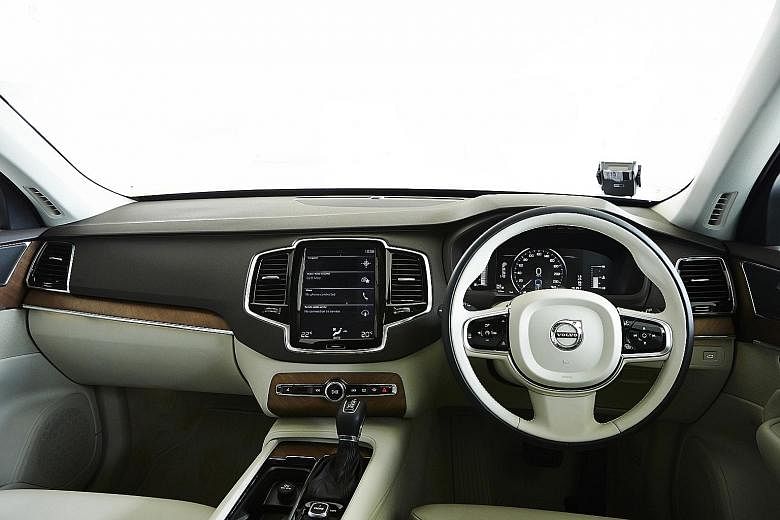These two big cars we have gathered here are the newest and most competent 2-litre four- wheel-drive seven-seater SUVs in Singapore.
At more than 5m in length, the Audi Q7 is not only longer than the XC90, its dimensions also rival those of flagship saloons. Its road presence is further magnified by its chunky and muscular design.
The 2-litre Q7 looks identical to the 3-litre Q7, with both wearing the same TFSI badges on their tailgates, but the 2.0 has 19-inch alloy wheels, one size smaller than the 3.0's.
As with the Q7, you cannot tell that this XC90 is the base variant just by gazing at it from afar. You would have to spot the T5 badge on its tailgate to know for sure.
Climb into the cockpit of the Volvo and the only hints of its entry-level status are its smaller, simpler instrument cluster and the absence of a sunroof.
And unless you are a leather expert, you would not know that the upholstery is regular cowhide instead of finer Nappa.
-
SPECS/AUDI Q7 2.0
Price with COE: $304,600
Engine: 1,984cc 16-valve turbocharged four-cylinder
Transmission: Eight-speed automatic with manual override
Power: 252bhp at 5,000-6,000rpm
Torque: 370Nm at 1,600-4,500rpm
0-100kmh: 7.1 seconds
Top speed: 233kmh
Fuel consumption: 7.4 litres/ 100km
Agent: Premium Automobiles
-
SPECS/VOLVO XC90 T5 2.0
Price with COE: $285,000
Engine: 1,969cc 16-valve turbocharged four-cylinder
Transmission: Eight-speed automatic with manual override
Power: 254bhp at 5,500rpm
Torque: 350Nm at 1,500-4,800rpm
0-100kmh: 8.2 seconds
Top speed: 215kmh
Fuel consumption: 7.7 litres/ 100km
Agent: Wearnes Automotive
The massive touchscreen that controls the infotainment and other vehicle functions is identical to the ones in costlier XC90 variants.
This system, called Sensus, is more intuitive than the Q7's Multi Media Interface (MMI).
One of the Volvo system's niftiest features is the voice control function that lets you adjust the air- conditioning by just saying "I'm hot" or "I'm cold".
Other standard amenities include four climate zones and adaptive cruise control, which is not even standard on the top-end Q7 3.0.
Climb into the Q7 2.0 and the most obvious indicators that it is not the Q7 3.0 are the missing panoramic sunroof and the presence of analogue meters in place of Audi's snazzy, all-digital virtual cockpit system.
However, the Q7's interior quality is superior to that of the XC90. The switches have a pleasing tactility and the knurled finish on the control knobs is a particularly luxurious touch.
More importantly, the Q7 is more roomy and more practical than the XC90. The Audi has larger storage spaces for knick-knacks, a more spacious boot (in five-seater configuration) and more legroom in the second and third rows.
Access to seats No. 6 and 7 is also less tricky in the Q7 than in the XC90, because it has a bigger gap for children (or petite adults) to squeeze through.
But when it comes to third-row comfort, the XC90 is marginally better because it has air-con vents there. The Q7 offers no such amenity. Given the Singapore weather, third-row passengers are going to be less happy in the Audi than in the Volvo.
It is easier to switch between five- and seven-seat layouts in the Q7, however. Thanks to the car's powered third-row seats, pressing a button is all it takes to stow or deploy them.
For added convenience, these controls are located in the boot and also behind the second-row bench.
In the XC90, the folding/unfolding of the third-row seats has to be done manually and takes some effort.
When it comes to driving excitement, again the Q7 beats the XC90. The Audi's turbocharged 2-litre motor cranks out 252bhp and 370Nm, and does the 0-100kmh dash in 7.1 seconds - just more than a second quicker than the Volvo.
The Audi's faster century-sprint is mainly due to the fact that its kerb weight of 1,975kg is 78kg lighter than the XC90's. That amounts to one fewer adult on board.
Working with the lighter weight to outsprint the Volvo is the Q7's 20Nm higher torque. The XC90's T5 engine is a bit more powerful (by 2bhp), but it is the torque output, especially at lower revs, that really gets these huge cars going.
That said, the XC90 has more progressive power delivery than the Q7. Whether the Volvo is moving off from a standstill or cruising, its more linear performance makes it more predictable.
The Audi displays palpable turbo lag when you nail the throttle - the turbocharger takes just a bit longer to spool up before the boost arrives. But when it does, the acceleration feels stronger than what the XC90 is capable of.
When it comes to handling, the longer Q7 feels surprisingly more manoeuvrable than the XC90. Whether you are in a tight carpark or going around corners, the Audi is more hatchback-like to drive than the Volvo.
The XC90 is more suited to road trips, thanks to its fantastic seats. The Swedish carmaker is an expert when it comes to making seats, and the ones in the XC90 are tops in cossetting their occupants.
Adding to its long-distance motoring comfort is the adaptive cruise control system mentioned earlier, which operates seamlessly, automatically slowing down the vehicle when it detects cars ahead filtering into your lane.
If the system's speed settings could be adjusted in increments of 1kmh instead of 5kmh, it would be even more useful.
Clearly, the Audi Q7 2.0 is better for family men who do all their driving within Singapore. On the other hand, the XC90 T5 is more suitable for families who enjoy road trips across the Causeway.
•The writer is with Torque, a motoring monthly published by SPH Magazines.



